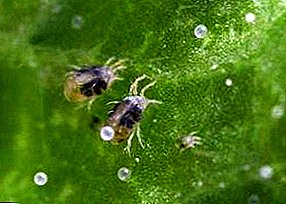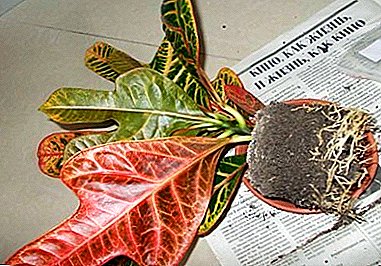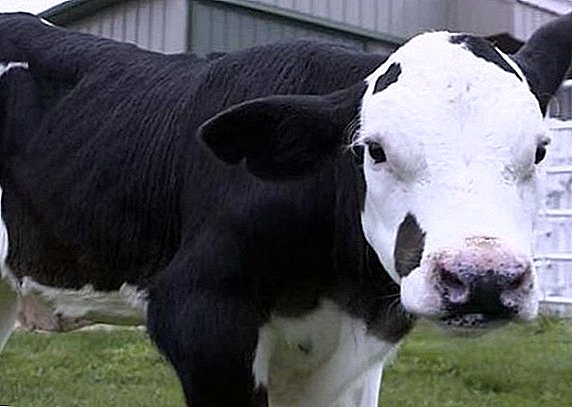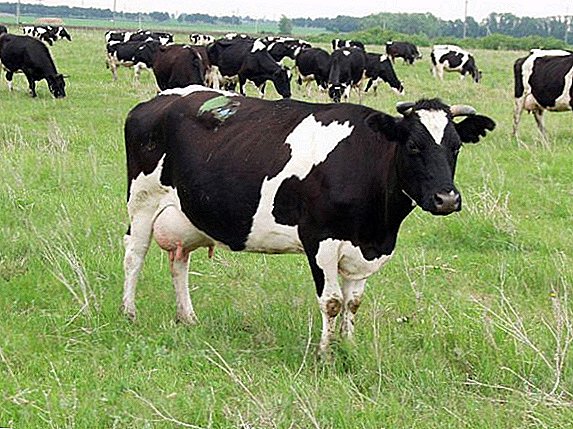 Today in our territory only small outbreaks of cattle EMKAR are registered periodically. However, this disease for more than a century is considered the most dangerous among infectious.
Today in our territory only small outbreaks of cattle EMKAR are registered periodically. However, this disease for more than a century is considered the most dangerous among infectious.
Most often infected with this disease cows. However, if the infection is not detected in time and adequate actions are not taken, the disease can cause serious damage even to a large-scale animal husbandry. Therefore, today we will talk about the danger of EMCAR, how to identify it, how to treat it and whether it can be prevented.
What is emphysematous carbuncle (EMCAR)
This is the worst infection for the young. Vulnerable to the pathogen individuals aged 3-36 months, more adult animals have a natural immunity. Emphysematous carbuncle or EMCAR (lat. Gangraena emphysematosa) is a rapidly developing infectious disease. Accompanied by fever and the formation in the muscles of crepitus swelling.
Causes
Anaerobes (Clostridium chauvoei) are considered to be the main pathogenic organism in cattle. In the course of its activities, this microorganism generates a large number of spores and is able to maintain its vital activity for many years.
The grazing and walking areas are infected for the most part through feces and various excreta of diseased individuals. Clostridium chauvoei safely retains its activity both in the swampy zone and in waterless areas.
Important! The most dangerous are the zones infected from dead cows. The concentration of infection in such a place is excessive, so all dead animals should be burned or disposed of at the factories intended for this.In a state of rest, ECMAR cattle spores can remain in unprotected soil for years. Moreover, the low-temperature regime does not affect their viability. However, direct sunlight can destroy the pathogen in a day. Disputes also die during the two-hour continuous boiling. About 30 minutes wand will withstand temperatures of + 120-150 ° C.
 Disinfectants deal best with ECMAR. For example, the composition of mercuric chloride copes with the wand in 10 minutes, and formaldehyde in 15 minutes. An animal is infected with an alimentary method, as well as through damaged skin or mucous membranes.
Disinfectants deal best with ECMAR. For example, the composition of mercuric chloride copes with the wand in 10 minutes, and formaldehyde in 15 minutes. An animal is infected with an alimentary method, as well as through damaged skin or mucous membranes.Incubation period and signs
From the moment of infection in the body until the first symptoms appear, 1-2 days pass, in exceptional cases - 5 days. Usually, the disease occurs abruptly, it is acute and is found in most cases in a typical carbunculosis form. In some cases, ECMAR can occur in an abortive form. There are cases of superfast development of the disease in a septic, putrid form.
Did you know? Emphysematous carbuncle has been known for a long time. However, until 1872, the disease was considered one of the symptoms of anthrax. Differentiated the infection F. Chaber.
Acute form
In case of acute progression, the disease begins with the temperature rising to + 41-42 ° C. At the same time, in areas with improved muscles (neck, chest, thighs, croup, submandibular region), less often in the mouth and throat area there is a clear or blurry edematous swelling. It is increasing rapidly.
Puffiness initially has a dense shape and is characterized by an elevated temperature. At the same time, an abscess causes pain, while cracking, a crash is heard, and when tapping, a distinct tympanic percussion sound. At the opening of edema, a dirty-brown slush of foamy consistency with an unpleasant smell of burning oil is released from it.  Later the swelling becomes cool. The skin on the surface darkens and becomes dark red. The local lymph nodes are inflamed and enlarged. If carbuncles appear on the thighs or shoulders, the animal begins to limp and drag limbs. If the infection is localized in the mouth, the tongue is most often affected. If the pathogen has spread to the pharynx, the edema is palpable below the base of the auricle.
Later the swelling becomes cool. The skin on the surface darkens and becomes dark red. The local lymph nodes are inflamed and enlarged. If carbuncles appear on the thighs or shoulders, the animal begins to limp and drag limbs. If the infection is localized in the mouth, the tongue is most often affected. If the pathogen has spread to the pharynx, the edema is palpable below the base of the auricle.
Important! In the case when microorganisms affect deeper muscles, the diagnosis is established only at the opening.When the process of infection is gaining momentum, the condition of the livestock deteriorates. The fact that the disease develops can tell the behavior of cattle:
- depressed state;
- rejection of feed;
- ruminant instinct disappears;
- rapid breathing.
 Later, there is a decline in cardiac function, the pulse becomes rapid (100-120 beats per minute). Death overtakes in 1-2 days (sometimes - 3-10 days). Before death, the body temperature drops and becomes below normal.
Later, there is a decline in cardiac function, the pulse becomes rapid (100-120 beats per minute). Death overtakes in 1-2 days (sometimes - 3-10 days). Before death, the body temperature drops and becomes below normal.Super sharp
The ultrafast course of the disease is observed quite rarely and for the most part in young animals under the age of 3 months. The disease proceeds in a septic form, without forming carbuncles. The infected animal dies after 6-12 hours. The main symptoms of hyperacute form are:
- increased fever;
- loss of appetite;
- depressed state.

Atypical
EMCAR can occur in an atypical form. It is not fraught with death and is characterized only by the general depression of the animal and pain in the muscles. There is no abscesses in this type.
Important! Atypical type of emphysematous carbuncle is sick mostly old animals, which, with timely diagnosis of the disease, can be cured in 2-5 days.
Laboratory diagnosis
Since in some forms of EMCAR there are no obvious symptoms, and in case of acute development it can be confused with other infections, diagnosis should be carried out collectively. To do this, consider:
- clinical picture;
- lab tests;
- data of a pathoanatomical research of the fallen animal.

Laboratory testing is carried out in several ways:
- The material is stained with agents that interact only with individual types of bacteria.
- Pure infection is extracted in meat-peptone broth. Further study the nature of the pathogen to exclude activators of other diseases.
- The resulting microorganism is administered to laboratory animals (mainly guinea pigs), after which specific clinical symptoms are determined.
Pathologic examination
At autopsy, certain pathological changes are detected: in the subcutaneous tissue and abdominal cavity there is a noticeable swelling of the corpse, a frothy liquid is released from the nose.
Find out what cows are sick of.
Also at the opening you can see the following picture:
- In the area of the affected musculature, more or less pronounced crepitating edema is noticeable, at the opening of which the edematous swelling with bubbles appears. The muscles are colored black and red, filled with bloody slurry.
- When preparing an animal on the serous and mucous surfaces find hemorrhages.
- The blood is dark red, caked.
- The liver is enlarged, has necrotic foci. Most often small, but sometimes significant. In some cases, they merge, which is why the liver has a spongy structure.
- The spleen is filled with blood, flabby.

Methods of struggle and treatment
EMCAR is considered a completely treatable disease. Therapy is especially effective in early diagnosis.
Important! Veterinarians warn that if an emphysematous carbuncle is suspected, it is impossible to open a corpse in conditions that are not equipped for this - the likelihood of infection is high.
Disinfection
Immediately after identifying the diseased animal, it is isolated. The barn is treated with disinfectants:
- formaldehyde;
- lime chloride;
- caustic sled
 The isolator in which the diseased animals are located is also subjected to regular disinfection. Frequency of treatment: once a day, according to the schedule and after each feces of a sick individual. The remaining fodder is burned. If there was a case, then the corpses of the dead animals, fodder, manure, items of care that were exploited at work, are burned.
The isolator in which the diseased animals are located is also subjected to regular disinfection. Frequency of treatment: once a day, according to the schedule and after each feces of a sick individual. The remaining fodder is burned. If there was a case, then the corpses of the dead animals, fodder, manure, items of care that were exploited at work, are burned.Important! Quarantine is removed only when the signs of infection do not appear within 14 days.
When diagnosing an emphysematous carbuncle, the farm is immediately closed for quarantine, during which the following rules are followed:
- It is prohibited to export cattle outside the farm and transfer them to other farms;
- until complete elimination of the pathogen, one should not mix organized groups of animals;
- all livestock unplanned vaccinated;
- feed stocks, litter and manure cannot be removed from the farm;
- Do not use milk and meat from infected animals.

Veterinary drugs
EMCAR requires an integrated approach to treatment. The main drugs that are used in this case are antibiotics. But, at the same time, they use disinfectants, which are injected subcutaneously, and also wash the carbuncles with special solutions. Most often, for the treatment of infection using these drugs (all done intramuscularly):
- Penicillin. One injection is administered every 6 hours until complete recovery or stabilization of the general condition. Dose - 3000-5000 units per 1 kg of animal weight.
- Biomitsin. Enter once a day for five days. Dosage - 3-4 mg per 1 kg of weight.
- Dibiomycin. Quantity - 1 injection one-time. Dosing - 40000 units per 1 kg of live weight.
- Amoxicillin. The number of injections - 2 per course with an interval of 2 days. Dosage - 15 mg per 1 kg of weight.
 Recently, new-generation cephalosporin antibiotics have appeared, which are highly effective. Their only drawback - they are much more expensive than traditional ones. Simultaneously with the use of antibiotics, the affected areas are cut off with disinfectants. To do this, use:
Recently, new-generation cephalosporin antibiotics have appeared, which are highly effective. Their only drawback - they are much more expensive than traditional ones. Simultaneously with the use of antibiotics, the affected areas are cut off with disinfectants. To do this, use:- 5% lysol solution;
- 2% solution of hydrogen peroxide;
- 4% carboxylic acid solution;
- 0.1% solution of manganese.
Important! Chipping around the tumor will not work and is considered meaningless.If the abscess is opened and leakage is leaking from it, then these places should be systematically wiped with potassium permanganate or hydrogen peroxide solution.
Prevention and Vaccination
After suffering the disease, bovine immunity is formed. Significant activity such serums differ:
- Concentrated hydroxide aluminum formol vaccine. Protects the body for 6-7 months.
- Live immunobiological preparation. Gives immune protection for 12 months and longer.
- Live serum against malignant and emphysematous carbuncle.
 In order to prevent outbreaks of the disease, perform the veterinary-sanitary complex:
In order to prevent outbreaks of the disease, perform the veterinary-sanitary complex:- The newly adopted cattle are kept on a preventive quarantine.
- Conduct immunization of all vulnerable individuals residing in disadvantaged regions.
- Youngsters aged 3 months to 4 years old are vaccinated annually. Depending on the season of walking or the form of the vaccine, events are held 1-2 times a year (2 weeks before the start of the pasture season and six months later).
- Grazing of cattle should be carried out on runs with a small amount of moisture.
- You can water the animals with water from clean waters.
- Feed must be of high quality. Do not allow the ingestion of soil particles, excrement and other debris.
- If during the inspection of cattle there are concerns about the presence of EMCAR, individuals are immediately transferred to quarantine.
- Barns and other livestock facilities are regularly disinfected.
- You can not walk cattle near the cattle cemeteries.
Did you know? Geographical or soil-climatic links with EMCAR have not been established. Nozareal covers all natural areas.As you can see, EMCAR is among the quite dangerous infections of cattle, which often ends in the death of young animals. It is extremely difficult to treat the infection and in most cases everything ends in death. Therefore, the main focus should be on preventive measures and vaccination in order to avoid infection altogether.












